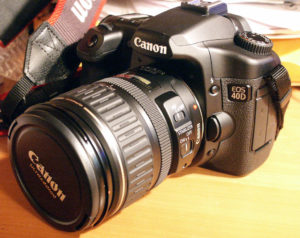All those reviews
I’ve been researching digital cameras quite a lot lately. I need something that produces better and more repeatable results than my smartphone, but I had to give this quite a lot of thought. There are a lot of very good, thorough photography and videography reviews out there, but you have to listen between the lines – what sort of results is this reviewer interested in? Chances are, the reviewer is going for an aesthetically pleasing result, whether the subject be brides or birds. There is nothing wrong with that, but the review is most often from that point of view. What we as field investigators are looking for is something different. So, when doing your research, keep that in mind.
Too Many Choices

The venerable Canon EOS 40D
Camera technology has vaulted ahead since I bought my Canon EOS 40D years ago – the last time I really looked into this. BTW, my EOS 40D is built like a tank and is still in great condition. Almost every camera shoots video now, and there are a wide range of options. Olympus, Panasonic and Sony have broken into the higher end of things alongside Canon and Nikon with some really good gear, and the old DSLR architecture has serious competition from the more compact mirrorless cameras. Things like autofocus, video resolution, and low light sensitivity have come a long way.
This is overall a good thing, but it’s like being in a candy store and your mom says you can only have 1 handful – it can be agonizing. you can do a lot to narrow things down by not starting with the technology, but with what your requirements are. Let me make a few suggestions.
Getting to What We Actually Need
You have to consider a few Design Reference Missions – in what scenarios do you need a camera, and in what conditions? There are the common uses, and some extraordinary but important circumstances when you want to be ready for anything:
Continue reading




